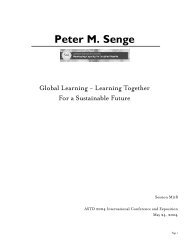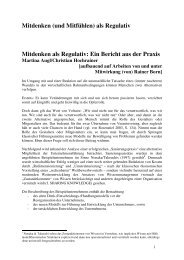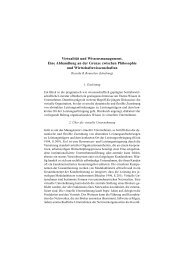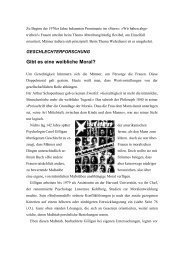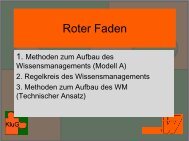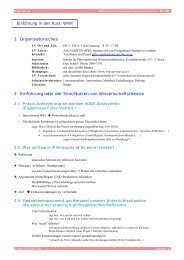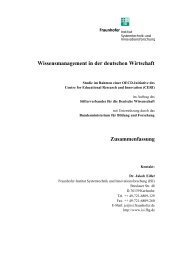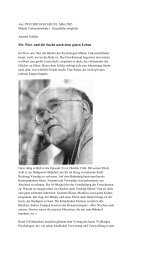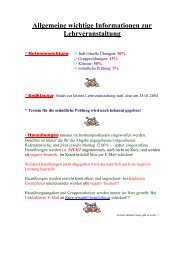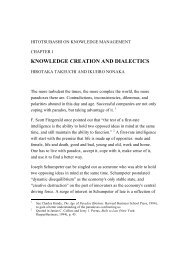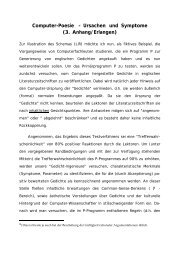The knowledge-creating theory revisited: knowledge creation as a ...
The knowledge-creating theory revisited: knowledge creation as a ...
The knowledge-creating theory revisited: knowledge creation as a ...
You also want an ePaper? Increase the reach of your titles
YUMPU automatically turns print PDFs into web optimized ePapers that Google loves.
Knowledge-<strong>creating</strong> <strong>theory</strong> <strong>revisited</strong> Ikujiro Nonaka and Ryoko Toyama 3<br />
We also need to understand that <strong>knowledge</strong> <strong>creation</strong> is<br />
a transcending process through which entities (individuals,<br />
groups, organizations, etc) transcend the boundary<br />
of the old into a new self by acquiring new <strong>knowledge</strong>. In<br />
the process, new conceptual artifacts and structures for<br />
interaction are created, which provide possibilities <strong>as</strong> well<br />
<strong>as</strong> constrain the entities in consequent <strong>knowledge</strong><strong>creation</strong><br />
cycles. Thus, the entities coexist with the<br />
environment because they are subject to environmental<br />
influence <strong>as</strong> much <strong>as</strong> the environment is influenced by<br />
the entities. This conceptualization of the interdependent<br />
connection between the entities and structure is<br />
similar to the Structuration <strong>theory</strong> (Giddens, 1984). <strong>The</strong><br />
existing theories that deal with a static status of an<br />
organization at one point of time cannot deal with such a<br />
dynamic process.<br />
This paper is a part of our attempt to build a new<br />
<strong>knowledge</strong>-b<strong>as</strong>ed <strong>theory</strong> of the firm and organization to<br />
explain the dynamic process of <strong>knowledge</strong> <strong>creation</strong> and<br />
utilization. For this, we revisit the <strong>theory</strong> of <strong>knowledge</strong><br />
<strong>creation</strong> through the SECI process (Nonaka, 1991;<br />
Nonaka & Takeuchi, 1995) and Ba (Nonaka et al., 2000a),<br />
and try to advance them further by incorporating the<br />
dialectic thinking such <strong>as</strong> Hegel, and Bh<strong>as</strong>kar (1993),<br />
E<strong>as</strong>tern philosophy, and the Structuration <strong>theory</strong> (Giddens,<br />
1984). We ac<strong>knowledge</strong> the ontological differences<br />
between Structuration <strong>theory</strong> and critical realism and<br />
utilize the Giddensian view mainly to explain the interrelation<br />
between the agents and the context, and critical<br />
realism <strong>as</strong> a methodology to explain the interaction<br />
between tacit and explicit <strong>knowledge</strong> or between the<br />
invisible and visible. <strong>The</strong> b<strong>as</strong>ic argument is that <strong>knowledge</strong><br />
<strong>creation</strong> is a synthesizing process through which an<br />
organization interacts with individuals and the environment<br />
to transcend emerging contradictions that the<br />
organization faces. This interconnection between agents<br />
and the structure makes the <strong>knowledge</strong> process to occur<br />
<strong>as</strong> a dynamic and inter-linked interaction from an<br />
individual-to-societal level.<br />
Organization <strong>as</strong> information-processing machine<br />
vs <strong>knowledge</strong>-<strong>creating</strong> entity<br />
<strong>The</strong> traditional organization <strong>theory</strong> is b<strong>as</strong>ed on the view<br />
of an organization <strong>as</strong> an information-processing machine<br />
that takes and processes information from the environment<br />
to solve a problem and adapts to the environment<br />
b<strong>as</strong>ed on a given goal. Because of the bounded rationality<br />
of human beings, an organization is necessary to deal<br />
with a complex reality. Reality is cut into pieces of<br />
information that are small and simple enough for one<br />
person to process. <strong>The</strong>n the information is processed and<br />
re<strong>as</strong>sembled by the organizational members so that<br />
the organization <strong>as</strong> a whole deals with the complex<br />
reality in the end. This can be e<strong>as</strong>ily understood with the<br />
example of car manufacturing. A car manufacturing<br />
process is broken down into various simple t<strong>as</strong>ks, and<br />
each worker is <strong>as</strong>signed one t<strong>as</strong>k so that even an unskilled<br />
worker can e<strong>as</strong>ily accomplish it. A worker does not need<br />
to understand what others are doing, and what his/her<br />
t<strong>as</strong>k means to the entire car manufacturing processes. <strong>The</strong><br />
issue for the organization, therefore, is how the entire<br />
process can be divided into small t<strong>as</strong>ks or modules and<br />
how they can be coordinated so that a car can be built in<br />
the end.<br />
This is a static and p<strong>as</strong>sive view of the organization and<br />
it fails to capture the dynamic process through which the<br />
organization interacts with the organizational members<br />
and the environment. Instead of merely solving problems,<br />
organizations create and define problems, develop<br />
and apply <strong>knowledge</strong> to solve the problems, and then<br />
further develop new <strong>knowledge</strong> through the action of<br />
problem solving. <strong>The</strong> organization and individuals grow<br />
through such process. <strong>The</strong> organization is not merely an<br />
information-processing machine, but an entity that<br />
creates <strong>knowledge</strong> through action and interaction (Nonaka<br />
et al., 2000b). In the process, the binding interdependence<br />
between the agents and environment offers<br />
possibilities and also initiates limits, which determine<br />
the boundaries for the <strong>knowledge</strong> <strong>creation</strong>. Further, in<br />
addition to structural interaction, dialectic <strong>knowledge</strong><br />
<strong>creation</strong> occurs <strong>as</strong> the actors embrace their environment<br />
and synthesize tacit and explicit <strong>knowledge</strong> in social<br />
space.<br />
Knowledge is not just a part of the reality. It is a reality<br />
viewed from a certain angle. <strong>The</strong> same reality can be<br />
viewed differently depending on from which angle (context)<br />
one sees it. In <strong>knowledge</strong> <strong>creation</strong>, one cannot be free<br />
from one’s own context. Social, cultural, and historical<br />
contexts are important for individuals (Vygotsky, 1986)<br />
because such contexts give the b<strong>as</strong>is for one to interpret<br />
information to create meanings. That is why limited<br />
environmental interaction and externalization of personal<br />
<strong>knowledge</strong> can lead to ontological ills and fallacies,<br />
because the whole complexity of given phenomenon<br />
may remain undiscovered. Hence, in <strong>knowledge</strong> <strong>creation</strong>,<br />
one tries to see the entire picture of reality by interacting<br />
with those who see the reality from other angles, that is,<br />
sharing their contexts. In the c<strong>as</strong>e of car manufacturing,<br />
the continuous process innovation that typically occurs<br />
at Toyota requires workers to view and understand their<br />
t<strong>as</strong>k <strong>as</strong> a part of the entire car manufacturing process, and<br />
share their <strong>knowledge</strong> about their t<strong>as</strong>k to make improvements<br />
on the process. It is important here to understand<br />
how the interactions among the parts (individuals, work<br />
groups, etc.) are dynamically linked to form a continuously<br />
evolving whole, which, in turn, impacts the environment<br />
where the car manufacturing takes place.<br />
Since individuals have different goals and contexts,<br />
contradictions are inevitable among individuals and the<br />
organization to which they belong. Traditional organization<br />
theories try to solve such contradictions through the<br />
design of organizational structure, incentive systems,<br />
routines, or organizational culture. However, if we view<br />
an organization <strong>as</strong> a <strong>knowledge</strong>-<strong>creating</strong> entity, we can<br />
see such contradictions <strong>as</strong> necessities to create <strong>knowledge</strong><br />
instead of obstacles to overcome. Knowledge is created<br />
Knowledge Management Research & Practice



